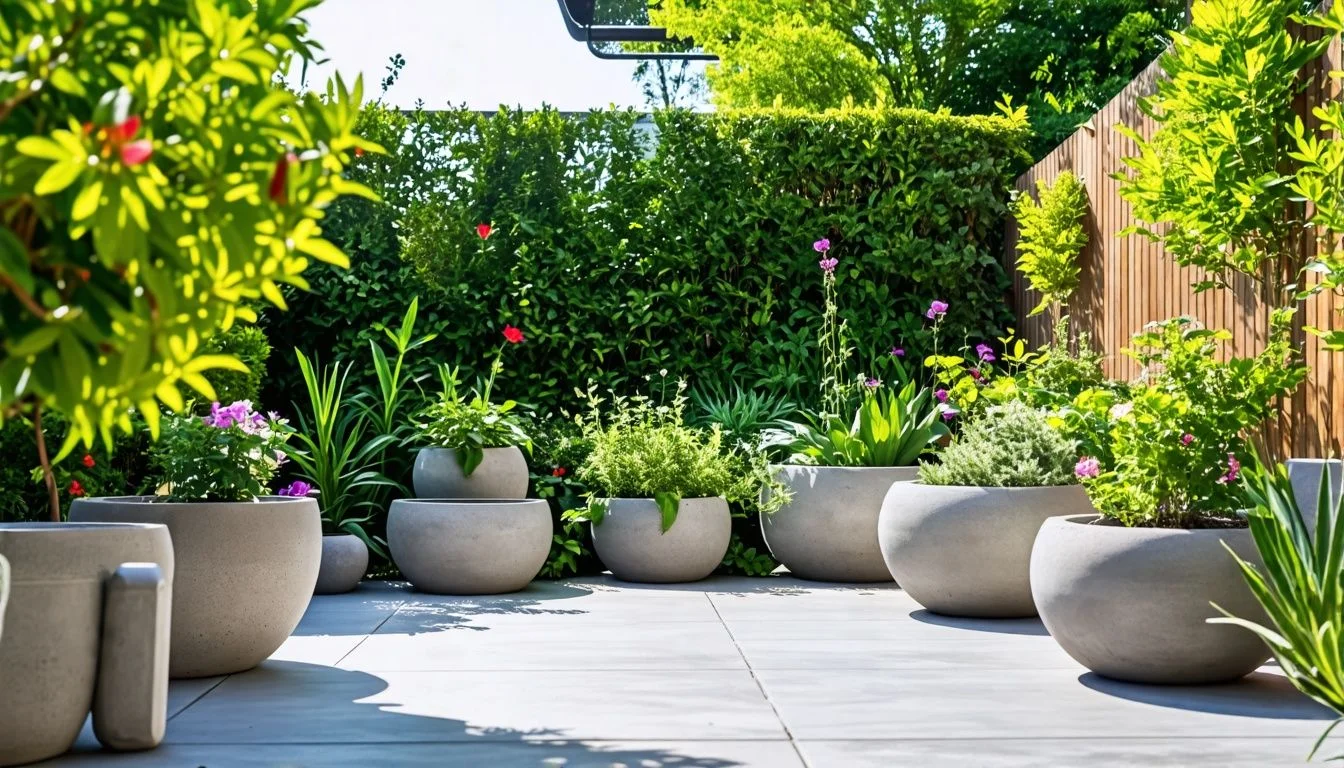Stone planters add timeless elegance and structure to any garden space. Whether you’re designing a formal courtyard, enhancing your patio, or creating visual interest in your landscape, selecting the right stone planters can transform your outdoor living area. This comprehensive guide will help you navigate the important considerations of size, material, and design to find the perfect stone planters for your specific needs.
The Appeal of Stone Planters
Stone planters have been used in garden design for centuries, from ancient Roman courtyards to modern minimalist landscapes. Their enduring popularity stems from several key advantages:
Durability and Longevity
Unlike wooden or plastic alternatives, high-quality stone planters from reputable manufacturers like Cranborne Stone can last for generations. These planters weather gracefully, often becoming more characterful with age as they develop a natural patina. The initial investment may be higher than other materials, but stone planters rarely need replacement, making them cost-effective in the long term.
Thermal Regulation
Stone provides excellent insulation for plant roots, maintaining more stable soil temperatures throughout seasonal changes. This thermal mass helps protect plants from temperature extremes—keeping roots cooler in summer and offering some protection from frost in winter. For delicate plants or in regions with variable climate conditions, this natural temperature regulation can improve plant health and vigor.
Aesthetic Versatility
From rustic, weathered limestone to sleek, contemporary granite, stone planters complement virtually any garden style. Their neutral tones provide the perfect backdrop for vibrant plant displays while adding architectural interest to the garden even during dormant seasons when plants may be less showy.
Selecting the Right Size for Your Stone Planters
Size is perhaps the most crucial practical consideration when selecting stone planters. The right dimensions depend on several factors:
Plant Requirements
Different plants have different root space needs:
- Shallow-rooted annuals and herbs may thrive in planters just 8-12 inches deep
- Perennials typically require 12-18 inches of soil depth
- Small shrubs need at least 18-24 inches of depth
- Trees and large shrubs may require 24-36 inches or more
When in doubt, choose a slightly larger planter than you think you need—this provides more soil volume, which means better moisture retention and room for root growth.
Visual Proportion
The size of your stone planters should be proportional to their surroundings:
- For entryways, choose planters approximately 1/3 the height of your doorway
- On patios, planters should generally be no more than 1/4 the width of the space
- In large gardens, undersized planters will appear lost—select substantial pieces that can serve as focal points
Many garden designers from Cranborne Stone recommend following the “rule of thirds” when positioning planters—placing them at intersections of imaginary grid lines that divide your space into thirds both horizontally and vertically.
Practical Considerations
Remember that stone planters are exceptionally heavy, especially when filled with soil. Consider:
- Can your intended location support the weight?
- Will the planter need to be moved seasonally?
- Do you have equipment or assistance for installation?
For raised patios or roof gardens, consider lighter reconstituted stone options that provide the aesthetic of natural stone with reduced weight.
Choosing the Right Stone Material
Not all stone planters are created equal. Different stone types offer varying aesthetic qualities, durability characteristics, and price points:
Limestone Planters
Limestone planters from specialists like Cranborne Stone feature a warm, organic appearance that complements traditional garden designs beautifully. The porous nature of limestone allows for some breathability, which can benefit plant health. However, this porosity also makes it more susceptible to staining and frost damage in severe climates unless properly sealed.
Limestone typically weathers to a lovely patina over time, developing character that many gardeners prize. It’s often available in cream, buff, and gray tones that provide a neutral backdrop for colorful plantings.
Granite Planters
Granite offers exceptional durability and resistance to weathering, making it ideal for harsh climates. Its crystalline structure creates a distinctive speckled appearance that works well in contemporary designs. While less porous than limestone, granite requires less maintenance and resists staining.
The trade-off for this durability is that granite planters typically command premium prices and can appear somewhat severe in very traditional gardens unless softened by abundant plantings.
Cast Stone Planters
Cast stone (also called reconstituted stone) planters blend stone aggregate with cement to create pieces that mimic the appearance of natural stone. Cranborne Stone and other quality manufacturers have perfected techniques that make cast stone nearly indistinguishable from quarried stone.
Advantages of cast stone include:
- More consistent color and texture
- Custom sizing options
- Potential weight reduction
- Generally lower price point than solid stone
For most home gardeners, high-quality cast stone planters offer an excellent compromise between aesthetic appeal, durability, and budget.
Design Considerations for Stone Planters
Beyond material and size, the design of your stone planters significantly impacts their visual contribution to your garden:
Style Compatibility
Your planters should complement your home’s architectural style and your garden’s design language:
- Classical urns and pedestals enhance formal gardens and traditional homes
- Clean-lined, geometric planters suit contemporary spaces
- Trough-style planters with weathered finishes work well in cottage and country gardens
Cranborne Stone offers collections spanning multiple design traditions, making it easier to find pieces that align with your existing aesthetic.
Drainage Solutions
Proper drainage is essential for plant health in any container. Stone planters should feature:
- Pre-drilled drainage holes of sufficient size
- Slight elevation from the ground using feet or a plinth
- Interior space for a layer of drainage material
If your chosen planter lacks adequate drainage, consult with the manufacturer about modification options before purchase.
Frost Resistance
In regions with freezing winters, frost resistance becomes crucial. When water freezes inside stone pores, it expands and can cause cracking—a process called spalling. To minimize this risk:
- Select dense stone varieties with minimal porosity
- Look for planters with thicker walls that provide better insulation
- Consider planters with tapered sides that allow for ice expansion
- Apply appropriate sealants as recommended by manufacturers like Cranborne Stone
Some gardeners in severe climates opt to empty and cover stone planters during winter months, though properly manufactured frost-resistant planters can typically remain planted year-round.
Placement Strategies for Stone Planters
The location of your stone planters affects both the visual impact of your garden design and the health of your plants:
Creating Focal Points
Use substantial stone planters to:
- Mark transitions between garden rooms or sections
- Draw attention to entryways or garden features
- Anchor corners of patios or terraces
- Frame views or create sight lines through the garden
A pair of matching planters can create formality and symmetry, while a single significant piece can serve as a sculptural element in its own right.
Considering Plant Needs
Different locations offer varying light conditions, exposure to elements, and visual prominence:
- South-facing locations receive more sunlight but may require more frequent watering
- North-facing positions provide cooler, shadier conditions suitable for woodland plants
- Windy sites may necessitate heavier, more stable planter designs
- Sheltered locations allow for more delicate plant choices
Match your planter placement to the requirements of your intended plantings for optimal success.
Long-term Positioning
Remember that once filled, large stone planters become extremely difficult to relocate. Before installation, consider:
- How the planter will relate to plants that may grow or spread over time
- Seasonal sun patterns and how they might affect your plantings
- Access needs for maintenance and watering
- Visual impact during all seasons, not just when plants are at their peak
Taking time to visualize these factors before finalizing placement will help ensure long-term satisfaction with your stone planter arrangement.
Maintaining Your Stone Planters
Quality stone planters require minimal maintenance, but a few simple practices will extend their beauty and longevity:
Seasonal Care
- In autumn, remove fallen leaves that could stain stone surfaces
- Before winter, check that drainage remains clear to prevent water accumulation and freezing
- In spring, gently clean surfaces with a soft brush and mild, non-acidic cleaner if necessary
- Throughout growing seasons, monitor for and address any developing stains or algae growth
Products specifically formulated for stone care, often recommended by manufacturers like Cranborne Stone, are worth the investment for valuable garden features.
Sealing Considerations
Whether to seal stone planters depends on:
- The specific stone type
- Your local climate conditions
- The planter’s exposure to potential staining agents
- Manufacturer recommendations
Generally, limestone and more porous stones benefit from periodic sealing every 1-3 years, while dense granites may require minimal or no sealing. Follow supplier guidelines for optimal results.
Planting Recommendations for Stone Containers
The right plants will enhance the beauty of your stone planters while thriving in container conditions:
Classic Combinations
Certain plants have traditionally paired well with stone planters:
- Clipped boxwood, bay laurel, or yew for formal settings
- Cascading ivy and flowering annuals for romantic cottage looks
- Mediterranean herbs like rosemary, lavender, and thyme in sunny locations
- Hostas, ferns, and astilbe for shaded areas
These traditional combinations have stood the test of time for good reason—they complement the permanence and solidity of stone with appropriate scale and texture.
Design Principles
For stunning container displays:
- Include plants with different heights, forms, and textures
- Consider the “thriller, filler, spiller” approach—a tall focal plant, mid-level plants for mass, and trailing plants to soften edges
- Select plants with similar care requirements to ensure all thrive together
- Include some evergreen elements for year-round structure
Well-designed plantings enhance the architectural qualities of your stone planters while introducing seasonal interest and movement.
Conclusion
Selecting the right stone planters involves careful consideration of size, material, design, and placement—but the rewards are substantial. These durable garden elements from quality manufacturers like Cranborne Stone will continue enhancing your outdoor spaces for years or even decades to come, developing character and patina as they age gracefully alongside your garden.
Whether you choose the classic elegance of limestone, the enduring strength of granite, or the versatility of cast stone, your investment in well-chosen stone planters will pay dividends in both aesthetic enjoyment and garden functionality. Take time to research options, consider your specific garden conditions, and select pieces that truly complement your outdoor living space.







Leave a Reply